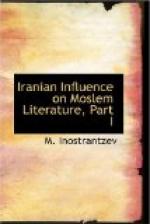[Footnote 1: Istakhri, p. 203, Ibn Hauqal, p, 266, 256, Makdisi pp. 396 and 445, Ibn Rusteh, p. 166.]
[Footnote 2: Yakubi, pp. 274, 279-280.]
[Footnote 3: Makdisi, pp. 126, 194.]
ISTAKHRI AND IBN HAUQAL[1]
Relate that the inhabitants of several localities of Kerman during the entire Umayyad period openly professed Mazdaism.
In a more detailed fashion, however, the Arab writers notice the Mazdian dwellers of Fars, the heart of the Persian dominion. Makdisi says that in Fars existed the customs of fire-worshippers but that the fire-worshipping inhabitants of the capital of the province of Shiraz had no distinguishing mark on their clothes; from which it follows that in that age these people were in no way differentiated from the Musalman subjects.[2] Istakhri[3] and Ibn Hauqal[4] relate that the bulk of the inhabitants of Fars consisted of fire-worshippers and they were there in larger number than anywhere else, Fars being the centre of sacerdotal and cultural life of the empire in the days of Persian independence. Very minute information is supplied us by these writers[5] regarding the ancient castles and fire-temples scattered over the whole of Fars in abundance. The latter is of capital importance since here was the residence of those two classes of Persian society, noblemen and priests, who were the staunchest conservators of the ancient national tradition.
[Footnote 1: Istakhri, p. 164; Ibn Hauqal, p. 221.]
[Footnote 2: See Makdisi, pp. 421, 429.]
[Footnote 3: P. 130.]
[Footnote 4: P. 207.]
[Footnote 5: Istakhri, pp. 116-119; also p. 100. Ibn Hauqal, 187-190; also p. 181.]
It is undoubted that the position of the Parsi community after the Moslem conquest was comparatively comfortable. Still sometimes it was darkened by excessive fanaticism and the intrigues of the followers of other faiths. Although sometimes the Parsis could push themselves forward to positions of officials and instructors and played an important part in the history of the Khalifate, generally speaking, this community was a close one leading a more or less exclusive life, a circumstance enabling the conservation of national peculiarities and attachment to antiquity. As time went on, however, the condition of their existence necessarily became worse and the consequence was the gradual emigration of a portion of the community from the motherland to Western India.
In the entire Parsi literature we come across only one historical composition which recounts this emigration. But the narrative is so obscure that of the main occurrence in it there must have remained only a general memory.[1] This book is called the “Kisseh-Sanjan” and was written at a very late date at the very close of the 16th century, so that the data given in it have to be looked upon as a reverberation of ancient tradition.[2]




